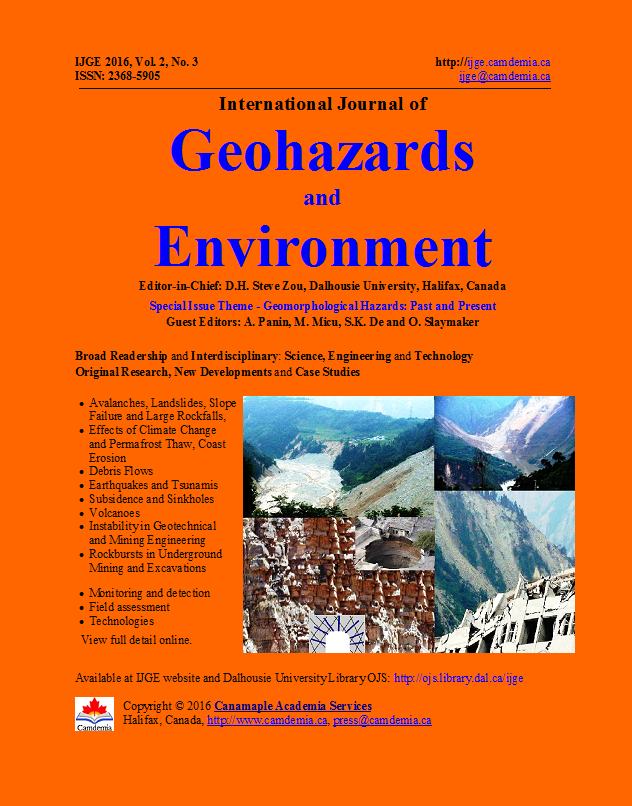A Review of Three Significant Geohazards in the Canadian Cordillera: the Case of River Floods, Debris Flows/Floods, and Debris/Rock Avalanches
DOI:
https://doi.org/10.15273/ijge.2016.03.011Keywords:
Canadian Cordillera, geohazards, forestry, mining, agriculture, urbanization, river floods, debris flows/floods, debris/rock avalanchesAbstract
Research into sudden-onset geohazards, such as river floods, debris flows/floods and debris/rock avalanches is prominent in literature on the Canadian Cordillera. The unresolved question is the relative importance of river floods, debris flows/floods and debris/rock avalanches over shorter and longer time scales and at smaller and larger spatial scales. River flooding is the costliest geohazard at regional scale and over century time scales but debris/rock avalanches are the deadliest at individual slope scale and over seasonal time scale. In terms of work done on the landscape, debris flows/floods are the most pervasive geohazard and have a huge influence on the long-term moulding of the landscape but figure less prominently in terms of fatalities and cost. Intensified land use, such as forestry, mining, agriculture and urbanization, is the primary reason for the increase in the cost of geohazards to society over the past three decades but climate change adds further uncertainties to the assessment of future geohazards.Downloads
Issue
Section
License
Copyright, Terms and Conditions
The International Journal of Geohazards and Environment (the Journal) is published by Canamaple Academia Services (the Publisher) online with open access, under a Creative Commons Attribution-Noncommercial license (CC-BY-NC) (http://creativecommons.org/licenses/by-nc/4.0/). Authors (the Authors) submitting papers (the Work) for publication in the Journal automatically agree to the following terms and conditions.
1. Under the license (CC-BY-NC), Authors give permission for others to share and reuse the Work, as long as the original source and author(s) are properly cited (i.e. a complete bibliographic citation and link to the Journal website) and the material is not used for commercial purposes. Any sharing or reuse must however indicate the original CC-BY-NC license terms of the work.
2. Authors transfer and assign to the Publisher all copyright in and to the Work. However Authors retain all proprietary rights except the copyright, related to the Work and also retain the rights a) to use, reproduce, distribute, and publicly display the Work in any medium in connection with the Authors‘ academic and professional activities, such as teaching, presentations and lectures, b) to create derivative works from the Work and to make full use of the Work in future research and publications, c) to authorize others to make any non-commercial use of the Work, d) to make both the pre-published and final-published versions available online in institutional and/or disciplinary repositories or on their own websites with a citation and link to the original paper published in the Journal.
3. Authors warrant that the Work is their original work, it is not copied from anywhere or anyone else, they are totally responsible for the authenticity, originality, validity and accuracy, and the facts and views are their own, that the Work contains no matter which is defamatory or infringes any literary or proprietary rights, intellectual property rights, or any rights of privacy, and that the Work has not been simultaneously submitted to any other journals or publishers. Authors further agree that their manuscripts whether accepted or rejected will not be returned and the rejected manuscripts will be disposed at the journal editor's discretion.
Disclaimer: The Publisher, the Journal and the editors accept no responsibility for statements or opinions expressed by authors. Use of information and materials in the Journal is the sole responsibility of users.


